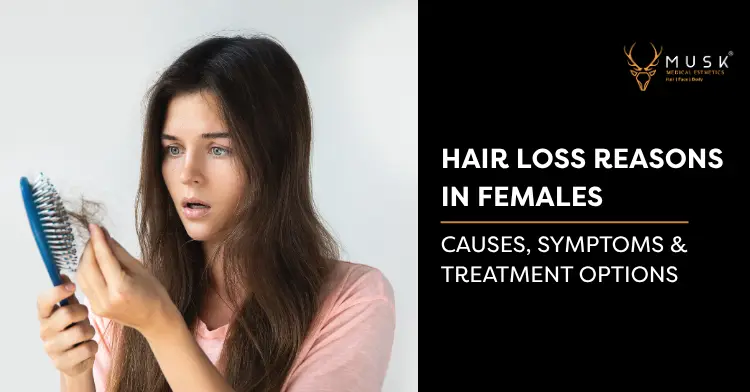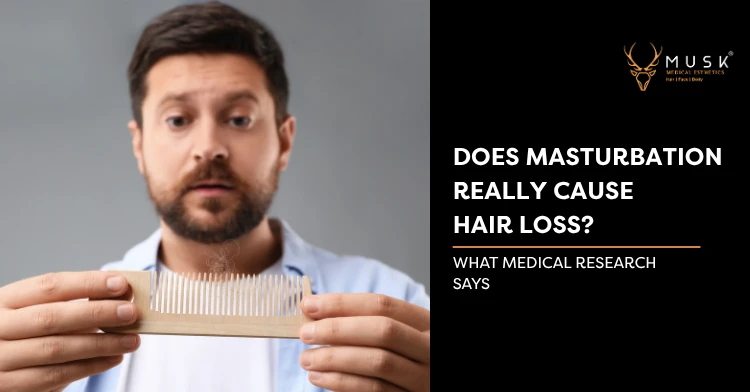Hair Loss Reasons in Females: Causes, Symptoms & Treatment Options

Key Takeaways
- Over 50% of women experience noticeable hair loss in their lifetime, making it far more common than most people realize
- Female pattern hair loss (androgenetic alopecia) affects about 30 million women in the United States alone
- Early intervention matters — catching hair loss in its early stages significantly improves treatment outcomes
- Multiple causes exist — from hormones and stress to nutrition and genetics, understanding your specific trigger is essential
- Effective treatments are available — from FDA-approved medications to advanced procedures like PRP therapy and robotic hair transplants
- Most cases are treatable — with proper diagnosis and personalized care, many women successfully restore their hair and confidence
What Is Female Hair Loss?
Female hair loss, medically called alopecia, happens when women lose more than 125 hairs per day. This disrupts the natural balance where some hairs fall out while others grow in.
Here's what's normal: You naturally shed between 50 and 100 hairs daily. But when hair falls out faster than it grows back, you'll notice thinning, bald spots, or a widening part.
The good news? Understanding why it happens is the first step toward fixing it.
How Does Hair Normally Grow?
Your hair goes through a continuous cycle with three distinct phases:
1. The Growth Phase (Anagen)
This is when your hair actively grows. Scalp hair stays in this phase for 3 to 6 years. The longer this phase lasts, the longer your hair can grow.
2. The Transition Phase (Catagen)
A short 2-week period where hair stops growing and detaches from its blood supply.
3. The Resting Phase (Telogen)
Hair rests for about 3 months before falling out. New hair starts growing in the same follicle, pushing the old hair out.
When something disrupts this cycle, hair loss occurs.
What Are the Signs of Hair Loss in Women?
Recognizing hair loss early makes treatment more effective. Watch for these symptoms:
1. Gradual Thinning on Top
The most common sign. Your part gradually widens, and you notice less volume on your crown. Unlike men, women rarely develop a receding hairline.
2. Increased Shedding
Finding handfuls of hair in your brush, on your pillow, or clogging your shower drain. This is especially noticeable when washing or styling.
3. Visible Scalp
When you pull your hair back, you can see more scalp than before. Your ponytail feels thinner.
4. Patchy Bald Spots
Circular or coin-sized patches where hair is completely missing. Your scalp might feel itchy or tender before the hair falls out.
5. Changes in Texture
Hair becomes brittle, dry, or breaks easily. This often accompanies thinning.
6. Sudden Hair Loss
After physical or emotional trauma, you might notice dramatic shedding. Hair comes out in clumps during washing or gentle tugging.
What Causes Hair Loss in Women?
Multiple factors can trigger hair loss. Let's break down the most common reasons of hair loss and types of hair loss in women.
1. Female Pattern Hair Loss (Androgenetic Alopecia)
What it is: The leading cause of hair loss in women, affecting about 30 million Americans.
How it happens: Your hair follicles become sensitive to androgens (male hormones present in small amounts in women). This sensitivity causes follicles to shrink over time, producing thinner, shorter hairs.
What you'll notice: Gradual thinning at your crown and along your part. The hairline usually stays intact.
Who gets it: Women with a family history, especially after menopause. It can start as early as your 20s but becomes more common with age.
2. Telogen Effluvium (Stress-Related Shedding)
What it is: Temporary excessive shedding triggered by physical or emotional stress.
Common triggers:
- Childbirth (postpartum hair loss)
- Major surgery or illness
- High fever
- Severe emotional stress
- Rapid weight loss
- Stopping birth control pills
What you'll notice: Sudden, dramatic shedding 2-3 months after the triggering event. Hair comes out in handfuls.
Recovery: Usually resolves on its own within 6-8 months once your body adjusts.
3. Hormonal Changes
Pregnancy and Postpartum: During pregnancy, elevated estrogen keeps more hair in the growth phase. After delivery, hormone levels drop sharply, causing massive shedding.
Menopause: Declining estrogen and progesterone slow hair growth. Androgen effects become more pronounced, leading to thinning.
Thyroid Disorders: Both overactive (hyperthyroidism) and underactive (hypothyroidism) thyroid glands disrupt the hair growth cycle.
PCOS (Polycystic Ovary Syndrome): Excess androgens can cause scalp hair loss while increasing facial and body hair.
4. Nutritional Deficiencies
Your hair needs specific nutrients to grow. Deficiencies in these can cause hair loss:
Iron: Iron deficiency (anemia) is one of the most common nutritional causes of hair loss in women.
Vitamin D: Low levels are linked to various types of hair loss, including alopecia areata.
Protein: Severe protein deficiency forces your body to ration protein away from hair growth.
Zinc: Essential for hair tissue growth and repair.
B Vitamins: Particularly biotin deficiency, though this is rare.
5. Alopecia Areata
What it is: An autoimmune disorder where your immune system mistakenly attacks hair follicles.
What you'll notice: Smooth, round bald patches appearing suddenly. Can progress to total scalp hair loss (alopecia totalis) or complete body hair loss (alopecia universalis).
Who gets it: Can happen at any age. Often runs in families with other autoimmune conditions.
6. Traction Alopecia
What it is: Hair loss from constant pulling or tension on hair follicles.
- Tight ponytails, braids, or buns
- Hair extensions or weaves
- Tight hair rollers
- Constantly wearing hats or headbands
Prevention: Use looser styles. Vary your hairstyle. Give your hair regular breaks from tension.
7. Medical Conditions and Medications
Several health conditions and drugs can trigger hair loss:
Medications:
- Blood thinners
- Beta-blockers
- Antidepressants
- Chemotherapy drugs
- Acne medications (isotretinoin)
Medical Conditions:
- Lupus (systemic lupus erythematosus)
- Diabetes
- Scalp infections (ringworm)
- Lichen planopilaris (scarring alopecia)
8. Chemical and Heat Damage
What causes it:
- Harsh chemical treatments (perms, relaxers, bleaching)
- Excessive heat styling (flat irons, blow dryers)
- Rough handling when wet
- Over-processing
The result: Weakened hair shaft that breaks easily, creating the appearance of thinning.
How Is Female Hair Loss Diagnosed?
Getting the right diagnosis is crucial for effective treatment.
1. When to See a Doctor
Contact a dermatologist if you experience:
- Sudden or patchy hair loss
- Hair loss that causes distress
- More than usual shedding when washing or brushing
- Visible bald spots
2. What to Expect During Your Visit
Medical History Review: Your doctor will ask about:
- Family history of hair loss
- Recent illnesses, surgeries, or stressful events
- Medications and supplements
- Hair care habits
- Diet and nutritional habits
Physical Examination: The doctor examines your scalp, checks for inflammation or scaling, and assesses your hair loss pattern.
Pull Test: Gently tugging on hair to see how many strands come out. This helps determine if shedding is excessive.
Blood Tests: To check for:
- Thyroid function
- Iron levels
- Vitamin D levels
- Hormone levels
- Other potential deficiencies
Scalp Biopsy: In unclear cases, a small scalp sample is examined under a microscope.
Trichoscopy: Using a specialized microscope to examine hair and scalp in detail.
What Treatments Work for Female Hair Loss?
Treatment depends on the cause. Here are proven options.
1. FDA-Approved Medications
Minoxidil (Rogaine):
- Available over-the-counter in 2% and 5% strengths
- Applied directly to the scalp twice daily
- Promotes hair growth and slows thinning
- Results visible in 4-6 months
- Must continue indefinitely to maintain results
- Side effects: Scalp irritation, unwanted facial hair
Oral Medications:
- Spironolactone: Blocks androgens, especially helpful for PCOS-related hair loss
- Finasteride: Used off-label in postmenopausal women
- Low-dose oral minoxidil: Emerging treatment showing promising results
2. In-Clinic Procedures
2.1 Platelet-Rich Plasma (PRP) Therapy:
A revolutionary regenerative treatment that harnesses your body's own healing power to restore hair growth. PRP uses concentrated growth factors from your blood to awaken dormant hair follicles and stimulate natural regrowth.
How it works: A small amount of your blood is drawn and processed in a centrifuge to separate and concentrate on the platelet-rich plasma. This nutrient-rich solution, packed with growth factors and proteins, is then precisely injected into areas of thinning or hair loss on your scalp.
What it treats: Highly effective for:
- Female pattern hair loss (androgenetic alopecia)
- Early to moderate hair thinning
- Weak, brittle hair that lacks volume
- Post-pregnancy hair loss
- Stress-related hair shedding (telogen effluvium)
Treatment schedule: Most patients undergo 3-4 initial sessions spaced 4-6 weeks apart, followed by maintenance treatments every 4-6 months to sustain results.
Benefits:
- 100% natural—uses your own blood, eliminating risk of allergic reactions
- Non-surgical with minimal discomfort
- No downtime—resume normal activities immediately
- Stimulates collagen production and improves scalp health
- Strengthens existing hair while promoting new growth
- Results visible within 3-6 months
Side effects: Minimal. You may experience mild scalp tenderness, slight swelling, or temporary redness at injection sites for 24-48 hours.
At Musk Clinic, PRP therapy has become a popular non-surgical option for women seeking natural hair restoration solutions. Our experienced team customizes each treatment to your unique hair loss pattern, ensuring optimal results.
2.2 Mesotherapy:
A targeted injection treatment that delivers a customized blend of vitamins, minerals, amino acids, and growth factors directly into your scalp. These micro-injections nourish hair follicles at the root level, improving circulation and strengthening weak hair.
How it works: Small doses of nutrients are injected into the mesoderm (middle layer) of your scalp using fine needles. This direct delivery system ensures maximum absorption where it's needed most.
What it treats: Particularly effective for:
- Diffuse hair thinning
- Early-stage androgenetic alopecia
- Hair quality improvement
- Post-pregnancy hair loss
- Nutritional deficiency-related hair loss
Treatment schedule: Typically requires 8-10 sessions spaced 1-2 weeks apart, followed by maintenance sessions every 1-3 months.
Benefits:
- Minimally invasive with little to no downtime
- Stimulates dormant hair follicles
- Improves hair thickness and texture
- Enhances overall scalp health
- Can be combined with other treatments like PRP or medications
Side effects: Mild scalp tenderness, temporary redness, or slight swelling at injection sites. These usually resolve within 24-48 hours.
At Musk Clinic, mesotherapy is customized to your specific hair loss pattern and nutritional needs, offering a non-surgical approach to revitalizing thinning hair.
2.3 Low-Level Laser Therapy (LLLT):
An FDA-cleared, non-invasive treatment that uses specific wavelengths of red light to energize and stimulate hair follicles at the cellular level. This phototherapy treatment is safe, painless, and can be done in the comfort of your home.
How it works: Medical-grade laser devices (combs, caps, or helmets) emit low-level laser light that penetrates the scalp to reach hair follicles. This light energy increases cellular metabolism, improves blood circulation, and encourages follicles to shift from the resting phase back into the active growth phase.
What it treats: Best suited for:
- Early to moderate androgenetic alopecia
- General hair thinning and reduced density
- Sluggish hair growth
- Supporting other treatments (works well with minoxidil or PRP)
Treatment schedule: Consistent use is crucial—typically 20-30 minutes, 3 times per week for at least 6 months to see noticeable results.
Benefits:
- Completely painless and non-invasive
- No chemicals or medications involved
- Can be used alongside other hair loss treatments
- Improves hair strength, thickness, and shine
- FDA-cleared for safety and effectiveness
- Convenient at-home treatment option
Side effects: Virtually none. Low-Level Laser Therapy (LLLT) is one of the safest hair loss treatments available. Some users report temporary scalp warmth during treatment.
Important note: Results vary by individual. LLLT works best when started early and used consistently. It's most effective for maintaining and strengthening existing hair rather than regrowing completely bald areas.
2.4 Corticosteroid Injections:
A targeted anti-inflammatory treatment specifically designed for autoimmune-related hair loss. These powerful injections deliver medication directly where it's needed—right into the affected areas of your scalp.
How it works: A dermatologist injects small amounts of corticosteroid medication (typically triamcinolone acetonide) directly into bald patches or areas of active hair loss. The medication suppresses the overactive immune response that's attacking your hair follicles, giving them a chance to recover and regrow.
What it treats: Primarily used for:
- Alopecia areata (patchy hair loss)
- Alopecia totalis (complete scalp hair loss)
- Alopecia universalis (total body hair loss)
- Inflammatory scalp conditions causing hair loss
- Scarring alopecia in early stages
Treatment schedule: Injections are typically administered every 4-6 weeks. Most patients need multiple sessions to achieve optimal regrowth. The number of treatments depends on the severity and extent of hair loss.
Benefits:
- Highly effective for autoimmune-related hair loss
- Works directly at the source of the problem
- Can halt progression of hair loss quickly
- Often produces visible regrowth within 4-8 weeks
- Minimal systemic side effects (medication stays localized)
- Can be combined with topical treatments
Side effects: Generally well-tolerated, but possible effects include:
- Temporary pain or discomfort at injection sites
- Small depressions in the skin (usually temporary)
- Lightening of skin at injection sites
- Thinning of the skin with repeated injections
Success rates: Studies show 60-70% of patients with alopecia areata experience significant hair regrowth with corticosteroid injections, especially when treated early.
Note: This treatment requires professional administration by a qualified dermatologist or hair restoration specialist. Regular follow-up appointments help monitor progress and adjust treatment as needed.
3. Surgical Solutions
Hair Transplantation: Healthy hair follicles are moved from donor areas (usually the back of your head) to thinning areas.
Modern techniques include:
- FUE (Follicular Unit Extraction): Individual follicles removed with minimal scarring
- Robotic Hair Transplant: Advanced ARTAS 9X technology offers precise, AI-guided follicle extraction
Musk Clinic specializes in robotic hair transplant procedures, combining cutting-edge technology with personalized care to deliver natural-looking results with minimal downtime.
4. Nutritional Supplements
Only use if deficient:
- Iron supplements (if anemic)
- Vitamin D
- Zinc
- Biotin (though deficiency is rare)
Important: Get tested before supplementing. Too much of certain nutrients can worsen hair loss.
5. Lifestyle Modifications
Scalp Care:
- Use gentle, sulfate-free shampoos
- Massage your scalp to improve circulation
- Avoid hot water when washing
Diet:
- Eat protein-rich foods
- Include omega-3 fatty acids
- Consume iron-rich foods (lean meat, spinach, lentils)
- Ensure adequate vitamin C for iron absorption
Stress Management:
- Practice meditation or yoga
- Get regular exercise
- Ensure adequate sleep
- Seek counseling if needed
Hair Handling:
- Use wide-toothed combs
- Avoid tight hairstyles
- Limit heat styling
- Be gentle when hair is wet
Cosmetic Solutions
While treating the underlying cause:
- Hair fibers: Keratin-based powders that cling to existing hair
- Scalp micropigmentation: Tattooing that creates the appearance of fuller hair
- Wigs and hairpieces: High-quality options that look natural
How Can You Prevent Hair Loss?
While you can't prevent genetic hair loss, you can reduce risk factors.
1. Be Gentle with Your Hair
- Avoid pulling, tugging, or rubbing hair roughly
- Use a detangler before brushing
- Pat hair dry instead of vigorous rubbing
- Brush from ends to roots, not the reverse
2. Maintain a Balanced Diet
Include foods rich in:
- Protein (eggs, fish, lean meat, legumes)
- Iron (red meat, spinach, lentils)
- Omega-3 fatty acids (salmon, walnuts, flaxseeds)
- Vitamins A, C, D, and E
- Zinc
3. Manage Stress Effectively
Chronic stress disrupts the hair growth cycle. Find healthy outlets like exercise, hobbies, or therapy.
4. Avoid Harsh Treatments
- Limit chemical processing
- Reduce heat styling
- Skip tight hairstyles
- Use protective products before heat styling
5. Get Regular Check-Ups
Annual bloodwork can catch thyroid problems, anemia, or other conditions early.
6. Quit Smoking
Research shows a connection between smoking and accelerated hair loss in both men and women.
What About the Emotional Impact?
Hair loss affects more than appearance. It impacts self-esteem, social confidence, and mental health. .
1. Acknowledge Your Feelings
It's normal to feel frustrated, sad, or anxious about hair loss. Your feelings are valid.
2. Seek Support
- Join online or local support groups
- Talk to friends or family
- Consider counseling or therapy
- Connect with others experiencing similar challenges
3. Focus on Treatment
Taking action helps you regain a sense of control. Working with healthcare professionals provides hope and direction.
At Musk Clinic, our team understands that hair restoration is about more than aesthetics—it's about restoring confidence and helping you feel like yourself again.
Conclusion: Your Path to Hair Restoration
Female hair loss is incredibly common, affecting over half of all women at some point in their lives. The causes range from genetics and hormones to stress, nutrition, and medical conditions.
The key takeaway? Early diagnosis and treatment make a significant difference. Don't wait until hair loss becomes severe. The sooner you identify the cause, the more treatment options you'll have.
Modern medicine offers numerous effective solutions—from topical medications and PRP therapy to advanced surgical procedures. With proper care, most women can slow hair loss, promote regrowth, and restore their confidence.
If you're experiencing hair loss, take action today. Schedule a consultation with a board-certified dermatologist or hair restoration specialist to create a personalized treatment plan. Your journey to healthier, fuller hair starts with that first step.
Ready to explore your options? Discover advanced hair restoration solutions at Musk Clinic and take control of your hair health today.
Frequently Asked Questions (FAQs)

Dr. Anand B. Shah
- 10 Years of Experience
Dr Anand B. Shah, is a board-certified Maxillofacial & Craniofacial surgeon who is highly skilled in cosmetic facial and hair restoration surgery and has exclusively practised the same, internationally and nationally.











